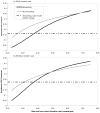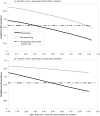HIV serosorting as a harm reduction strategy: evidence from Seattle, Washington
- PMID: 19834319
- PMCID: PMC2886722
- DOI: 10.1097/QAD.0b013e328330ed8a
HIV serosorting as a harm reduction strategy: evidence from Seattle, Washington
Abstract
Objective: We sought to estimate how serosorting may affect HIV prevalence and individual risk among men who have sex with men in Seattle, Washington, and how the results vary under different assumptions of HIV testing frequency, heterogeneity in sexual behavior, and condom use.
Methods: We developed a deterministic mathematical model of HIV transmission dynamics. Data from the 2003 random digit dial study of men who have sex with men conducted in Seattle, Washington (n = 400) are used to parameterize the model.
Results: Predicted population-level HIV prevalence as well as an individual's risk of HIV acquisition decreases when the odds of serosorting are increased in the mathematical model. In our model based on observed levels of serosorting, we predict an HIV prevalence of 16%. In contrast, if serosorting were eliminated in the population, we predict that HIV prevalence would increase to 24.5%. However, our findings depend on rates of condom use, mean anal sex contact rates, and HIV testing in the population.
Conclusion: Under realistic scenarios of sexual behavior and testing frequency for men who have sex with men in the United States, serosorting can be an effective harm reduction strategy.
Conflict of interest statement
There are no conflicts of interest.
Figures




Comment in
-
Available evidence does not support serosorting as an HIV risk reduction strategy.AIDS. 2010 Mar 27;24(6):935-6; author reply 936-8. doi: 10.1097/QAD.0b013e328337b029. AIDS. 2010. PMID: 20234196 No abstract available.
Similar articles
-
Trends in Serosorting and the Association With HIV/STI Risk Over Time Among Men Who Have Sex With Men.J Acquir Immune Defic Syndr. 2016 Jun 1;72(2):189-97. doi: 10.1097/QAI.0000000000000947. J Acquir Immune Defic Syndr. 2016. PMID: 26885806 Free PMC article.
-
Failure of serosorting to protect African American men who have sex with men from HIV infection.Sex Transm Dis. 2012 Sep;39(9):659-64. doi: 10.1097/OLQ.0b013e31825727cb. Sex Transm Dis. 2012. PMID: 22902660 Free PMC article.
-
Available evidence does not support serosorting as an HIV risk reduction strategy.AIDS. 2010 Mar 27;24(6):935-6; author reply 936-8. doi: 10.1097/QAD.0b013e328337b029. AIDS. 2010. PMID: 20234196 No abstract available.
-
A strategy for selecting sexual partners believed to pose little/no risks for HIV: serosorting and its implications for HIV transmission.AIDS Care. 2009 Oct;21(10):1279-88. doi: 10.1080/09540120902803208. AIDS Care. 2009. PMID: 20024704 Free PMC article. Review.
-
Sexual risk behaviour of men who have sex with men: emerging patterns and new challenges.Curr Opin Infect Dis. 2010 Feb;23(1):39-44. doi: 10.1097/QCO.0b013e328334feb1. Curr Opin Infect Dis. 2010. PMID: 19949328 Review.
Cited by
-
A cautionary tale: risk reduction strategies among urban American Indian/Alaska Native men who have sex with men.AIDS Educ Prev. 2013 Feb;25(1):25-37. doi: 10.1521/aeap.2013.25.1.25. AIDS Educ Prev. 2013. PMID: 23387949 Free PMC article.
-
Interaction of mathematical modeling and social and behavioral HIV/AIDS research.Curr Opin HIV AIDS. 2011 Mar;6(2):119-23. doi: 10.1097/COH.0b013e328343acad. Curr Opin HIV AIDS. 2011. PMID: 21505386 Free PMC article. Review.
-
Replacing clinic-based tests with home-use tests may increase HIV prevalence among Seattle men who have sex with men: evidence from a mathematical model.Sex Transm Dis. 2014 Jan;41(1):2-9. doi: 10.1097/OLQ.0000000000000046. Sex Transm Dis. 2014. PMID: 24335742 Free PMC article.
-
Conversation about Serostatus decreases risk of acquiring HIV: results from a case control study comparing MSM with recent HIV infection and HIV negative controls.BMC Public Health. 2014 May 14;14:453. doi: 10.1186/1471-2458-14-453. BMC Public Health. 2014. PMID: 24885694 Free PMC article.
-
Implications for HIV prevention programs from a serobehavioural survey of men who have sex with men in Vancouver, British Columbia: the ManCount study.Can J Public Health. 2012 Mar-Apr;103(2):142-6. doi: 10.1007/BF03404220. Can J Public Health. 2012. PMID: 22530539 Free PMC article.
References
-
- Kippax S, Race K. Sustaining safe practice: twenty years on. Soc Sci Med. 2003;57(1):1–12. - PubMed
-
- Dawson JM, Fitzpatrick RM, Reeves G, Boulton M, McLean J, Hart GJ, et al. Awareness of sexual partners’ HIV status as an influence upon high-risk sexual behaviour among gay men. Aids. 1994;8(6):837–41. - PubMed
-
- Golden MR, Brewer DD, Kurth A, Holmes KK, Handsfield HH. Importance of sex partner HIV status in HIV risk assessment among men who have sex with men. Jaids-Journal of Acquired Immune Deficiency Syndromes. 2004;36(2):734–742. - PubMed
-
- Mao L, Crawford JM, Hospers HJ, Prestage GP, Grulich AE, Kaldor JM, et al. “Serosorting” in casual anal sex of HIV-negative gay men is noteworthy and is increasing in Sydney, Australia. Aids. 2006;20(8):1204–6. - PubMed
Publication types
MeSH terms
Grants and funding
LinkOut - more resources
Full Text Sources
Medical

